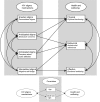The Relationship Between Stigma and Health-Related Quality of Life in People Living with HIV Who Have Full Access to Antiretroviral Treatment: An Assessment of Earnshaw and Chaudoir's HIV Stigma Framework Using Empirical Data
- PMID: 29417350
- PMCID: PMC6208921
- DOI: 10.1007/s10461-018-2041-5
The Relationship Between Stigma and Health-Related Quality of Life in People Living with HIV Who Have Full Access to Antiretroviral Treatment: An Assessment of Earnshaw and Chaudoir's HIV Stigma Framework Using Empirical Data
Abstract
The aim was to empirically test the tenets of Earnshaw and Chaudoir's HIV stigma framework and its potential covariates for persons living with HIV in Sweden. Partial least squares structural equation modelling was used on survey data from 173 persons living with HIV in Sweden. Experiencing stigma was reported to a higher extent by younger persons and by women who had migrated to Sweden. As expected, anticipated stigma was related to lower Physical functioning, and internalized stigma to lower Emotional wellbeing. In contrast to that hypothesized by the HIV stigma framework, enacted stigma was not related to Physical functioning and no relationships were found between HIV-related stigma and antiretroviral adherence. These results indicate that the HIV stigma framework may need to be revised for contexts where a very high proportion of persons living with HIV are diagnosed and under efficient treatment.
El objetivo fue probar empíricamente los postulados del marco teórico del estigma del VIH (HSF) de Earnshaw y Chaudoir y sus covariables para personas con el VIH en Suecia. Se empleó el modelo de ecuaciones estructurales con la escala PLS (Partial least squares), sobre datos obtenidos en 173 encuestas a personas con el VIH en Suecia. El estigma experimentado fue más frecuente en jóvenes y mujeres emigrantes. Como se esperaba, el estigma anticipado estuvo asociado a bajo funcionamiento físico, y el internalizado a bajo bienestar emocional. En contra de las hipótesis del HSF, el estigma declarado no tuvo relación con el funcionamiento físico y no se encontró ninguna relación entre el estigma relacionado con el VIH y la adherencia a los antirretrovirales. Estos resultados sugieren que el marco teórico HSF debería ser ajustado para contextos en los que un alto porcentaje de las personas con el VIH están diagnosticadas y bajo tratamiento eficaz.
Keywords: Adherence to ART; HIV stigma framework; HIV-related stigma; Health-related quality of life.
Conflict of interest statement
Conflict of interest
The authors declare that they have no conflict of interests.
Ethical approval
All procedures performed were in accordance with the ethical standards of the institutional and/or national research committee and with the 1964 Helsinki declaration and its later amendments or comparable ethical standards and were approved by the Regional Ethical Review Board of Stockholm (2008/1:12 with amendment 2013/335-32).
Informed consent
Informed consent was obtained from all individual participants included in the study.
Figures


Similar articles
-
Discrimination, Medical Distrust, Stigma, Depressive Symptoms, Antiretroviral Medication Adherence, Engagement in Care, and Quality of Life Among Women Living With HIV in North Carolina: A Mediated Structural Equation Model.J Acquir Immune Defic Syndr. 2019 Jul 1;81(3):328-335. doi: 10.1097/QAI.0000000000002033. J Acquir Immune Defic Syndr. 2019. PMID: 30893124 Free PMC article.
-
Towards a new understanding of HIV-related stigma in the era of efficient treatment- A qualitative reconceptualization of existing theory.J Adv Nurs. 2021 May;77(5):2472-2480. doi: 10.1111/jan.14774. Epub 2021 Feb 18. J Adv Nurs. 2021. PMID: 33599309
-
Pathways From HIV-Related Stigma to Antiretroviral Therapy Measures in the HIV Care Cascade for Women Living With HIV in Canada.J Acquir Immune Defic Syndr. 2018 Feb 1;77(2):144-153. doi: 10.1097/QAI.0000000000001589. J Acquir Immune Defic Syndr. 2018. PMID: 29135650 Free PMC article.
-
Symptom management in HIV/AIDS: advancing the conceptualization.ANS Adv Nurs Sci. 2005 Oct-Dec;28(4):333-44. doi: 10.1097/00012272-200510000-00005. ANS Adv Nurs Sci. 2005. PMID: 16292019 Review.
-
HIV-related stigma and health-related quality of life in women living with HIV in developed countries: a systematic review.AIDS Care. 2022 Jan;34(1):7-15. doi: 10.1080/09540121.2021.1891193. Epub 2021 Mar 5. AIDS Care. 2022. PMID: 33663284
Cited by
-
Measurement invariance of HIV-related stigma scales among men who have sex with men (MSM) and non-MSM populations: implications for comparative studies in China.Front Psychol. 2025 Apr 25;16:1510034. doi: 10.3389/fpsyg.2025.1510034. eCollection 2025. Front Psychol. 2025. PMID: 40351573 Free PMC article.
-
A Qualitative Examination of Perceived Stigma and its Sources Among Adolescents Living With HIV in Western Kenya.Glob Pediatr Health. 2022 Jan 6;9:2333794X211065335. doi: 10.1177/2333794X211065335. eCollection 2022. Glob Pediatr Health. 2022. PMID: 35024383 Free PMC article.
-
Prevalence of HIV-related stigma among people with HIV in Switzerland: addressing the elephant in the room.AIDS. 2024 Nov 1;38(13):1874-1884. doi: 10.1097/QAD.0000000000003983. Epub 2024 Jul 24. AIDS. 2024. PMID: 39051627 Free PMC article.
-
Cohort profile: InfCareHIV, a prospective registry-based cohort study of people with diagnosed HIV in Sweden.BMJ Open. 2023 Mar 17;13(3):e069688. doi: 10.1136/bmjopen-2022-069688. BMJ Open. 2023. PMID: 36931676 Free PMC article.
-
What do young people know about HIV? Results of a cross sectional study on 18-24-year-old students.J Prev Med Hyg. 2022 Dec 31;63(4):E541-E548. doi: 10.15167/2421-4248/jpmh2022.63.4.2555. eCollection 2022 Dec. J Prev Med Hyg. 2022. PMID: 36891004 Free PMC article.
References
MeSH terms
LinkOut - more resources
Full Text Sources
Other Literature Sources
Medical
Research Materials

